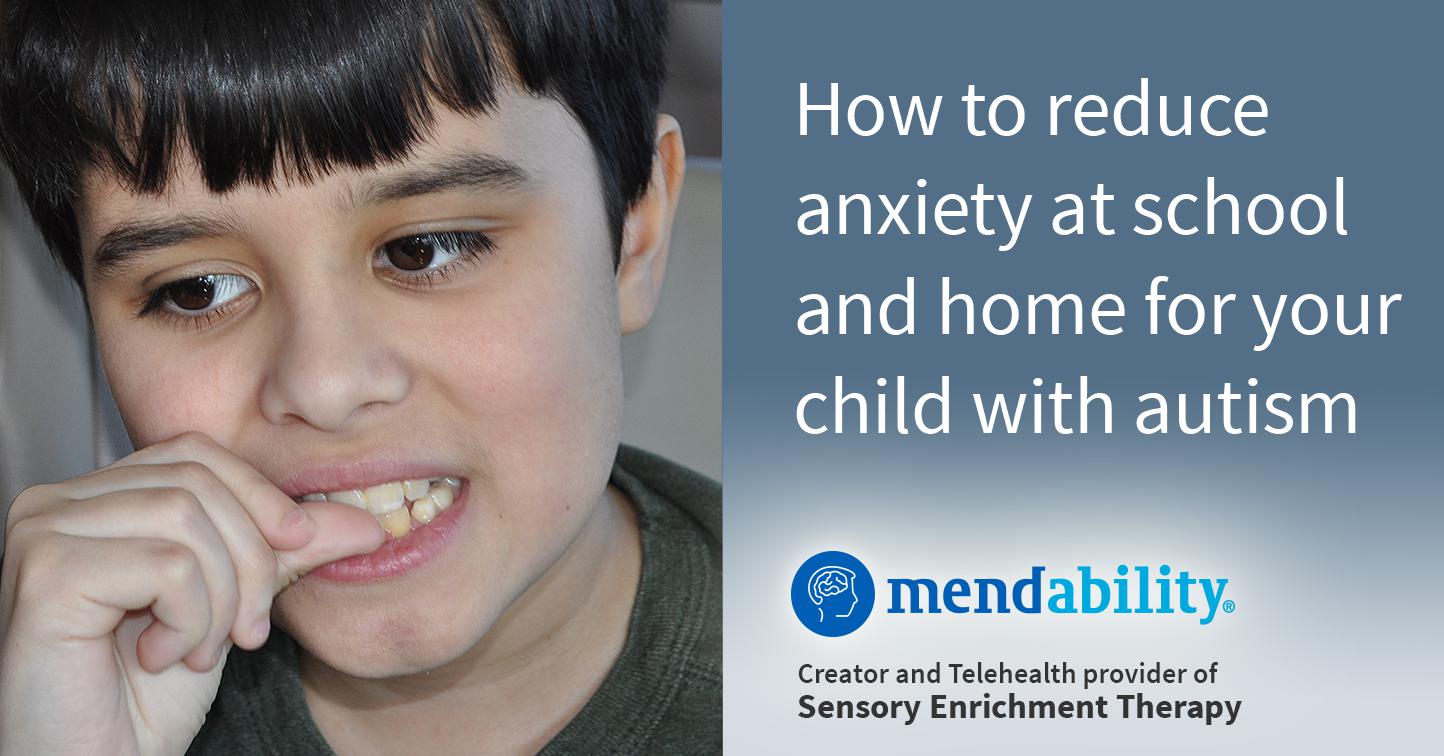Individuals with autism experience diverse symptoms that often have a direct impact on the lives of everyone in the family. Anxiety frequently affects choices and activities as caregivers adapt the environment, adjust routines, and sometimes avoid certain circumstances altogether.
Anxiety levels in children on the autism spectrum commonly peak during the school year and through the transition to/from school breaks. Beyond the dramatic change in routine, many expectations are placed on the child and often without explanation.
Reduce the sources of anxiety
Although it may seem that after the highly structured day at school, your child needs to come home to fewer rules and demands, the opposite is true for children with autism. These children need their time at home to follow predictable routines too. Routines and patterns help an autistic individual feel secure and can lessen his or her anxiety.
School is a loud and busy place. You can also help your child’s anxiety at home by reducing the sensory overload that he or she may be experiencing. Try to implement some of the following: speak with a soft voice; decrease the use of artificial light throughout your home; switch all phones to vibrate mode (turn off the ringer); decrease the volume of the TV or computer and turn down the brightness of any screens in your home.
Reduce anxiety about school
Here are some ideas that may help you to reduce your child’s anxiety symptoms at school and about school:
Visit the classroom
Talk with the teacher about the specific factors that impact your child’s anxiety levels. Help the teacher better understand your child and his or her concerns. Ask what you can do to support the classroom team.
Communicate with your child about school (Social Stories)
If your child is not strong in verbal communication, then you can use pictures to help with this discussion. With permission, take photos of your child’s classroom from different angles. Photograph the toys, the chairs and tables, the wall displays and work areas. You may also want to include pictures of the gym, playground, restrooms and lunch area. You can then create a slideshow that will help you to communicate with your child about his or her experiences at school. At the end of each school day, watch the slideshow together and point to areas or objects in the classroom. Try to assess how your child responds to the images. Learning how your child feels about his or her classroom and the activities that happen at school will help you to manage your child’s anxiety about school.
The Autism Parenting Magazine has a useful guide for social stories as well: https://www.autismparentingmagazine.com/social-stories-for-autistic-children/
Make a ‘school center’ at home
Based on the photos of your child’s classroom, create a small play center in your home with similar toys or activities to those used at school. Sometimes, you may be able to help your child with autism to work through difficult moments of his or her day at school by going over the event at home. Try to prepare your child for potential difficulties. For example, you could use the school play center to practice with your child how he or she will react to a conflict with a classmate about a toy. Sharing and waiting for turns are difficult concepts for all children. As you recreate situations from school, you can help your child with autism to prepare to handle those situations.
Sensory enrichment techniques can help reduce anxious buildup at school and at home
Give your child a scented bandana to wear or a scented handkerchief for his or her pocket
You will not be there to remind to your child to take a moment to stop and smell, but if your child wears a bandana with a scent on it, he or she will notice the smell from time to time during the day. If your child will be irritated by wearing a bandana, then you can put the scent directly onto the shoulder of his or her t-shirt or sweater.
Help your child relax at school with music and art
At times your child with autism may need to have some space away from the busy activities of the classroom. If you provide the teacher with headphones that your child will wear and a device that can play your child’s favorite instrumental music, then your child can recharge his or her emotional batteries for a few minutes by sitting in a quiet area and listening to music. Even better still would be a device that can display some art as a slideshow whilst playing music. If you can share a slideshow and some music with your teacher on a thumb drive or by providing website links, then your child may be able to access this activity on a school computer.
Provide a tactile activity for your child to do at school when feeling distressed
A set of tactile cards or a collection of safe, smooth objects to handle can be a very effective tool to help calm an autistic individual when his or her emotional overload peaks.
Reduce anxious buildup to increase learning
Anxiety in children with autism and Asperger’s syndrome is an expected component. While the school team is in charge of your child’s education, your efforts to reduce your child’s anxiety will increase the benefits of the learning experiences provided in the classroom. Managing each situation and anticipating the experiences that each day will bring can help you reduce the anxiety that your child with autism deals with at school and at home.
For additional information about the benefits of routines for autistic individuals, read:
- http://www.examiner.com/article/autism-routine-is-more-than-a-need
- http://www.autism.org.uk/living-with-autism/understanding-behaviour/obsessions-repetitive-routines/routines-and-change.aspx
- http://raisingchildren.net.au/articles/autism_spectrum_disorder_obsessions_routines.html
Is anxiety an area of concern for you or your loved one?
Sensory Enrichment Therapy™ helps develop resilience against stress, transitions and unexpected changes by boosting brain development in these areas.
Join 3,000 families in over 60 countries who have used Sensory Enrichment Therapy™ to help boost brain development in their own homes.

